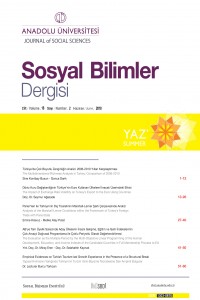AB’ye Tam Üyelik Sürecinde Aday Ülkelerin İnsani Gelişme, Eğitim ve Gelir İndekslerinin Çok Amaçlı Doğrusal Programlama ile Çoklu Periyotlu Olarak Değerlendirilmesi
Öz
Avrupa birliğine tam üye olmak aday statüsündeki ülkeler için oldukça önemlidir. Tam üyelik süreci uzun vadeli ekonomik ve sosyal reformlar gerektirmektedir. Avrupa Birliğine aday statüsünde olan ülkelerden hangisinin tam üyelik için hazır olduğunu belirlemek, bilimsel çalışmaların odaklandığı bir alan olmuştur. Bu çalışmanın amacı, Avrupa Birliği’ne tam üye olmak için aday statüsünde olan ülkeleri insani gelişim, sağlık, eğitim ve sosyo-ekonomik standartların belirlenmesinde etkili olan değişkenler yoluyla karşılaştırmaktır. Bu amaç doğrultusunda Avrupa birliğine tam üyelik sürecinde aday statüsünde olan Karadağ, Makedonya, Sırbistan ve Türkiye’nin 2005-2014 dönemi verileri analiz edilmiştir. Bir dizi kısıtlamalar kümesine bağlı olarak iki veya daha fazla birbiriyle çelişen amaçların arasında ödünleşmeler ile optimal bir çözüm sağlayan ve zaman boyutunu da ele alan çoklu periyotlu çok amaçlı programlama analizi yöntemi kullanılmıştır. Böylece, ağırlık sonuçlarına bağlı olarak, hangi ülkenin tam üyeliğine yakın olduğunu belirleyen bilimsel bir yaklaşım sunulmuştur.
Anahtar Kelimeler
Kaynakça
- Abu-Taha, R. (2011). “Multi-criteria applications in renewable energy analysis: A literature review”. Technology Management in the Energy Smart World (PICMET), 2011 Proceedings of PICMET ‘11:, 1-8.
- Agrawal, R, Singh, S. (2001). “Energy allocations for cooking in UP households (India): a fuzzy multi-objective analysis”. Energy conversion and management, 42(18), 2139-2154.
- Borghans, L, Heijke, H. (2005). “The production and use of human capital: Introduction”. Education Economics, 13(2), 133-142.
- Cherchye, L, Moesen, W, Rogge, N, Van Puyenbroeck, T. (2007). “An introduction to ‘benefit of the doubt’composite indicators”. Social Indicators Research, 82(1), 111-145.
- Cooper, W W, Seiford, L M, Tone, K. (2007). Data envelopment analysis: a comprehensive text with models, applications, references and DEA-solver software: Springer Science & Business Media.
- Cooper, W W, Seiford, L M, Zhu, J. (2011). Data envelopment analysis: History, models, and interpretations Handbook on data envelopment analysis (pp. 1-39): Springer.
- Dışişleri Bakanlığı. (2016). from http://www.mfa.gov.tr/ Ekonomi Bakanlığı. (2016). from http://www.ekonomi.gov.tr/
- Fukuda-Parr, S, Kumar, A S. (2004). Readings in Human Development: Concepts, measures and policies for a development paradigm: Oxford University Press, USA.
- Khalili-Damghani, K, Sadi-Nezhad, S, Tavana, M. (2013). “Solving multi-period project selection problems with fuzzy goal programming based on TOPSIS and a fuzzy preference relation”. Information Sciences, 252, 42-61.
- Kılıç, S B. (2005). “Avrupa Birliğine Üye ve Aday Ülkelerin Bazı Temel Makro Ekonomik Kriterlere Göre Sınıflandırılması: Çok Kriterli Karar Alma Analizine Dayalı Bir Modelin Tahmini”. Çukurova Üniversitesi Sosyal Bilimler Enstitüsü Dergisi, 14(2).
- Li, L, Lai, K K. (2000). «A fuzzy approach to the multiobjective transportation problem». Computers & Operations Research, 27(1), 43-57. doi: http://dx.doi.org/10.1016/S0305-0548(99)00007-6
- Lovell, C K, Pastor, J T. (1999). “Radial DEA models without inputs or without outputs”. European Journal of operational research, 118(1), 46-51.
- Mariano, E B, Sobreiro, V A, do Nascimento Rebelatto, D A. (2015). “Human development and data envelopment analysis: A structured literature review”. Omega, 54, 33-49.
- Melyn, W, Moesen, W. (1991). “Towards a synthetic indicator of macroeconomic performance: unequal weighting when limited information is available”.
- Murat, A, Filiz, Ö. (2003). “Avrupa Birliği’nin genişleme sürecinde Türkiye ve diğer aday ülkelerin ekonomik/ sosyal performanslarının karşılaştırılması”. İktisadi ve İdari Bilimler Fakültesi Dergisi, 5(2), 1-19.
- Norman, M, Stoker, B. (1991). Data envelopment analysis: the assessment of performance: John Wiley & Sons, Inc.
- Özden, Ü H. (2011). “Topsıs Yöntemi İle Avrupa Birliğine Üye ve Aday Ülkelerin Ekonomik Göstergelere Göre Sıralanması”. Trakya University Journal of Social Science, 13(2).
- San Cristóbal, J. (2011). “Multi-criteria decision-making in the selection of a renewable energy project in Spain: the Vikor method”. Renewable energy, 36(2), 498-502.
- Sherman, H D. (1982). “Data envelopment analysis as a new managerial audit methodology: test and evaluation”.
- Vassiloglou, M, Giokas, D. (1990). “A study of the relative efficiency of bank branches: an application of data envelopment analysis”. Journal of the Operational Research Society, 591-597.
- Vorkink, A. (2005). “Türkiye’de Eğitim Reformu”. Hacettepe Üniversitesi.
- Wold Databank. (2016). from http://databank.worldbank.org/data/
- Yaralıoğlu, K, Umarusman, N. (2010). “Çok Amaçlı Doğrusal Programlamadan Sistem Tasarımına: De Novo”. Dokuz Eylül Üniversitesi Sosyal Bilimler Enstitüsü Dergisi, 12(4).
- Yörüker, S, Karabeyli, L, Kaya, S, Özeren, B. (2003). “Sayıştayın performans ölçümüne ilişkin ön araştırma raporu”. Ankara: Sayıştay, Dizi, 28.
- Zimmermann, H. (1992). Fuzzy {Set Theory {and Its Applications Second, Revised Edition: Springer.
Ayrıntılar
| Birincil Dil | Türkçe |
|---|---|
| Bölüm | Makaleler |
| Yazarlar | |
| Yayımlanma Tarihi | 20 Haziran 2018 |
| Gönderilme Tarihi | 31 Mart 2017 |
| Yayımlandığı Sayı | Yıl 2018 Cilt: 18 Sayı: 2 |
Cited By
İnsani Gelişmişlik Endeksinin Karar Ağacı Algoritmaları ile Modellenmesi: BM’de Bir Uygulama 2010-2017 Dönemi
Anadolu Üniversitesi Sosyal Bilimler Dergisi
https://doi.org/10.18037/ausbd.758032
Bu eser Creative Commons Atıf-GayriTicari 4.0 Uluslararası Lisansı ile lisanslanmıştır.


